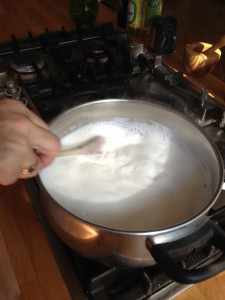Background about Crockpot Yogurt Honey and Seasonal Fruit Recipe
Since I had surgery on my small intestines, my chiropractor recommended that I start making my own yogurt, kefir, sauerkraut, and cultured vegetables to improve the positive bacteria in my digestive system. These are the microbes that actually help your body break foods down into nutritious parts like amino acids, vitamins, minerals, etc. For more information, start your research with http://bodyecology.com and Sherry Brescia’s page and newsletter at http://greattastenopain.com. By the way the Crockpot Yogurt Honey and Seasonal Fruit recipe is now a favorite of mine because homemade yogurt is yummo!!!
After researching this topic, I decided to start with yogurt because all the ingredients were easily accessible and reasonably priced. The next decision I made was investigating what local high quality milk would work best for me. I’ve read articles and recipes about using organic raw unpasteurized (which can only be found in Georgia for pets, by the way) vs. pasteurized milk, non-homogenized vs. homogenized milk. Here’s what I decided as a novice yogurt maker. I decided to use low temperature pasteurized, non-homogenized milk from a local farm, Southern Swiss Dairy. Low pasteurized milk yields fairly consistent yogurt and has many of the benefits of raw milk (cream floats to the top, etc.).
Once I make the yogurt, I store it in the refrigerator in one pint canning jars, with lids, that I’ve put through the dish washer to sterilize. Then, I eat the yogurt with honey and seasonal fruit. Here are some suggestions, based on what fruits are available in Georgia at any particular point in the season:
- Blackberries – July and August
- Blueberries – May through August
- Figs – August and September
- Grapefruit – Winter and Spring
- Mangoes – May and June
- Navel Oranges – Winter and Spring
- Valencies Oranges – Spring and Summer
- Peaches – June through September
- Persimmons – October through December
- Pumpkin – September and October
- Raspberries – July through September
- Strawberries – mid-April through mid-June
- Watermelon – June through August
My search topic was local, seasonal fruit. If you do not live in Georgia, you can search your area for the best fruits to add to your yogurt with honey. I also use yogurt as a dip with organic local, seasonal veggies and herbs as well as an enrichment for sauces (after I take the sauce off the burner.)
Even though wild-crafted, gourmet honey is harvested seasonally, your honey can be eaten at any time of the year. I’m including the gathering schedule as a matter of interest so that you can understand Nature’s plan for eating seasonally:
- Wildflower Honey – May-early June
- Sourwood Honey – late June to mid-July
- Orange Blossom Honey – Spring
By the way, developing the recipe site was quite an extensive project that our readers asked for. Please feel free to purchase our products and refer customers to support continuing the Honey Recipe site: http://beewild.buzz.
Ingredients
- 8 cups low temp pasteurized organic or natural milk
- 1/3 - 1/2 cup organic whole milk yogurt with live cultures
Instructions
- Turn you Crockpot on low and let it warm up while you are heating the milk.
- Put 1/3 - 1/2 cup yogurt in a clean glass or stainless steel bowl,
- Pour milk in a clean glass or stainless steel saucepan. Put on medium heat.
- Heat milk, while continuously stirring, until it reaches 160 degrees F. (You can use a candy thermometer to check the temp.) The milk will be close to a boil with frothy bubbles along the side (See first photo.)
- Take the milk off the heat and cover the pan. Place the covered pan in a sink of cold water and cool the mild down to 140 degrees F. This will take between 5-10 minutes.
- Then, stir about 1/2 to 1 cup of the milk into the bowl with the yogurt.
- Add that mixture to the rest of the milk and combine well.
- Turn off the Crockpot.
- Pour the milk and yogurt mixture into the Crockpot and put the lid on.
- Surround the Crockpot with a beach towel or other heavy towel. (See second photo.)
- Check the yogurt in 12 hours. Yogurt solids should be floating in whey.
- Strain off the solids and put them in containers.
- Set aside 1/2 cup of the new yoghurt for starting your next batch.
Notes
You can use cheese cloth to further strain the yogurt, if you like Greek style. I found this to be pretty difficult and gave up, since the yogurt was plenty thick.
I serve about 2/3 cup of yogurt with fresh organic, local, seasonal fruit and 1 tbsp of Bee Wild' honey.









